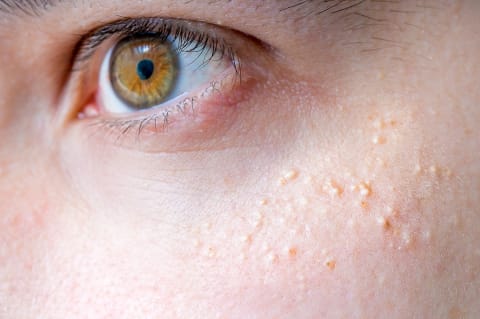Milia, aka milk spots, are itty-bitty white or yellow bumps on the surface of the skin. While they may look like little acne breakouts, they’re not and shouldn’t be treated the same. Milia are actually cysts filled with keratin under the skin and are most commonly found on the face above the cheekbones and under the eyes. Ahead, we tapped three dermatologists to learn what milia actually is, why you get it, and how to treat it for good. Villanueva says it can also be caused by a lack of sleep, smoking, and poor personal hygiene habits. But chances are if you’ve developed milia, checking your skin care products for heavy ingredients that tend to clog pores is a wise first step. If you don’t fall into either of those categories, but still develop milia, it may be due to a lack of hydration in the skin. Villanueva warns that dry skin doesn’t exfoliate adequately and can tend to be more prone to developing milia. “It’s not recommended to remove milia at home,” Villanueva suggests. “They aren’t easy to remove and can easily cause damage to your skin.” And no, don’t try to pop them. As always, that’s a big no-no. Not only will you not have success (remember, this isn’t a whitehead), but you can cause further damage and irritation. In fact, Barr and Villanueva agree the best and safest option is to visit your dermatologist for an extraction. The procedure itself is pretty simple and practically pain-free. But do know that the deeper the cyst is, the larger the incision. Barr also suggests allowing your milia to resolve on their own. “The truth is that you don’t need to treat unless they are a cause for concern,” she suggests. “They typically resolve on their own over time.” Bottom line: The choice is up to you. But whatever you do, don’t try to pop or remove them at-home.



